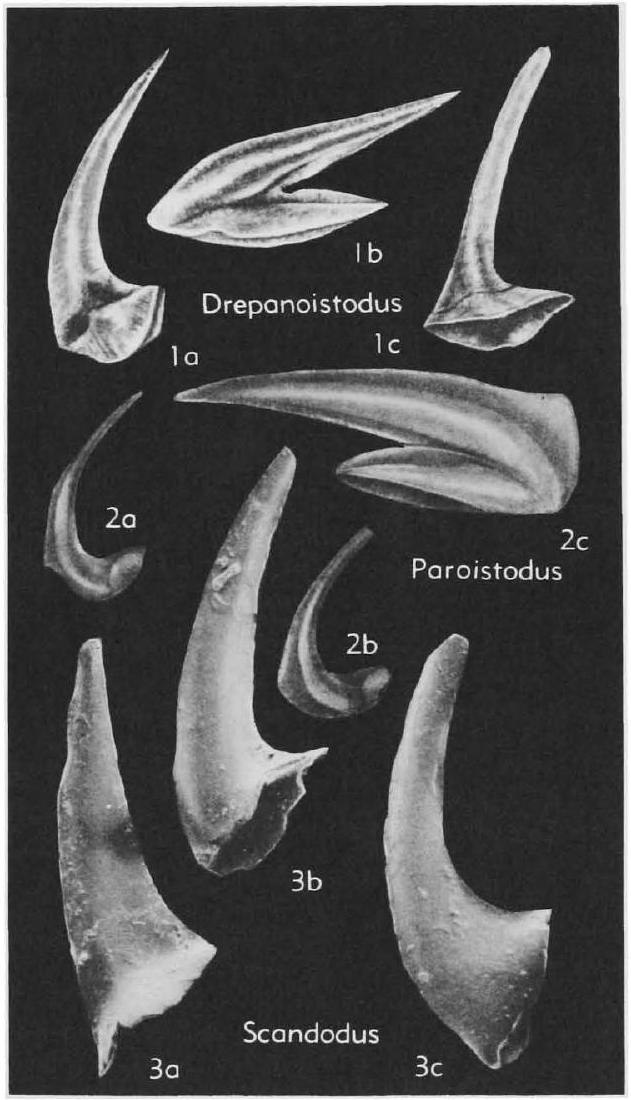Welcome to the Treatise on Invertebrate Paleontology!
Please enter a genera name to retrieve more information.

Drepanoistodus
Classification
Phylum:
Conodonta
Class:
Conodonta
Order:
Conodontophorida
Superfamily:
Distacodontacea
Family:
Drepanoistodontidae
Formal Genus Name and Reference:
Drepanoistodus LINDSTRÖM, 1971, p. 42
Type Species:
Oistodus forceps LINDSTRÖM, 1955, p. 574, OD
Images
(Click to enlarge in a new window)
Fig. 91, 1. *D.sally extended into very short lobes. M.Ord., N.Am.--FIG. 92,4. 'M. primw, Harding Ss., USA(Colo.); 4a,b, lat. views, X40 (Sweet, 1955).
Synonyms
Geographic Distribution
Ord., Eu.-N.Am.-Asia-Australia
Age Range
Beginning Stage in Treatise Usage:
Ord.
Beginning International Stage:
Tremadocian
Fraction Up In Beginning Stage:
0
Beginning Date:
486.85
Ending Stage in Treatise Usage:
Ord.
Ending International Stage:
Hirnantian
Fraction Up In Ending Stage:
100
Ending Date:
443.07
Description
"Apparatus basically bimembrate but some forms with two or more types of nongeniculate elements. Geniculate elements with long reclined cusp and posteriorly extended base. Nongeniculate elements with long, recurved to suberect cusp, one lateral face of which may be carinate. Basal cavity restricted to base. [VAN WAMEL (1974) regarded both Paltodlls PANDER, 1856 and Scandodus LINDSTROM, 1955 as synonyms of Drepanoistodus; however, he erroneously used Drepanoistodus for this group of conodonts despite the fact that the former generic names have many years' priority over Drepanoistodus. Apparatus reconstruction: BERGSTROM & SWEET, 1966; LINDSTROM, 1971.J
References
Ziegler, Willi, , & Lindström, Maurits, 1971, Über Panderodus Ethington, 1959, und Neopanderodus n. g. (Conodonta) aus dem Devon: Neues Jahrb. Geol. Palacontol. Monatsh., Jahrg. 1971, no. 10, p. 628640, 3 text-fig.
Museum or Author Information
Classification
Phylum:
Conodonta
Class:
Conodonta
Order:
Conodontophorida
Superfamily:
Distacodontacea
Family:
Drepanoistodontidae
Formal Genus Name and Reference:
Drepanoistodus LINDSTRÖM, 1971, p. 42
Type Species:
Oistodus forceps LINDSTRÖM, 1955, p. 574, OD
Images
(Click to enlarge in a new window)
Fig. 91, 1. *D.sally extended into very short lobes. M.Ord., N.Am.--FIG. 92,4. 'M. primw, Harding Ss., USA(Colo.); 4a,b, lat. views, X40 (Sweet, 1955).
Synonyms
Geographic Distribution
Ord., Eu.-N.Am.-Asia-Australia
Age Range
Beginning Stage in Treatise Usage:
Ord.
Beginning International Stage:
Tremadocian
Fraction Up In Beginning Stage:
0
Beginning Date:
486.85
Ending Stage in Treatise Usage:
Ord.
Ending International Stage:
Hirnantian
Fraction Up In Ending Stage:
100
Ending Date:
443.07
Description
"Apparatus basically bimembrate but some forms with two or more types of nongeniculate elements. Geniculate elements with long reclined cusp and posteriorly extended base. Nongeniculate elements with long, recurved to suberect cusp, one lateral face of which may be carinate. Basal cavity restricted to base. [VAN WAMEL (1974) regarded both Paltodlls PANDER, 1856 and Scandodus LINDSTROM, 1955 as synonyms of Drepanoistodus; however, he erroneously used Drepanoistodus for this group of conodonts despite the fact that the former generic names have many years' priority over Drepanoistodus. Apparatus reconstruction: BERGSTROM & SWEET, 1966; LINDSTROM, 1971.J
References
Ziegler, Willi, , & Lindström, Maurits, 1971, Über Panderodus Ethington, 1959, und Neopanderodus n. g. (Conodonta) aus dem Devon: Neues Jahrb. Geol. Palacontol. Monatsh., Jahrg. 1971, no. 10, p. 628640, 3 text-fig.
